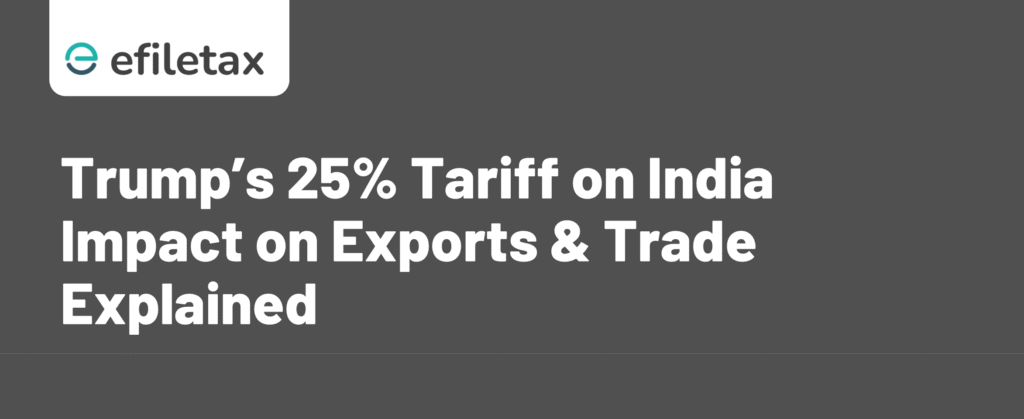
Trump’s 25% Tariff on Indian Imports: What Indian Exporters Must Know
Focus keyphrase: Tariff on Indian imports
In a move that has rattled Indian exporters, former US President Donald Trump has proposed a 25% tariff on all Indian imports if re-elected in 2025. While still a campaign promise, this sharp trade stance has triggered concerns across India’s export-driven sectors — from textiles to pharmaceuticals. In this blog, we decode what the proposed tariff on Indian imports means for Indian trade, businesses, and compliance professionals.
Why This Tariff Threat Matters
- India is the 9th largest goods exporter to the US (2023 data).
- US accounts for over 17% of India’s total exports.
- The 25% blanket tariff could disrupt bilateral trade worth over $118 billion.
Key Sectors at Risk
| Sector | 2023 Export Value (US$) | Impact if Tariff Hits |
|---|---|---|
| Textiles & Apparel | $8.3 billion | High – cost-sensitive industry |
| Pharmaceuticals | $7.1 billion | Moderate – regulated buyers |
| Gems & Jewellery | $9.4 billion | High – price competitiveness hit |
| Machinery & Equipment | $6.7 billion | Moderate – B2B contracts exposed |
| Organic Chemicals | $5.8 billion | High – margin pressure expected |
Legal & Trade Context: Is This WTO-Compliant?
- WTO Rules (Article I & II of GATT) discourage arbitrary tariffs on MFN (Most Favoured Nation) partners like India.
- India could challenge this at WTO’s Dispute Settlement Body, citing violation of non-discrimination.
- However, under US national security or emergency provisions, certain tariff actions can be legally insulated.
👉 Reference: WTO GATT Rules – wto.org
Impact on Indian Exporters and MSMEs
- Margin erosion: Indian goods may become costlier than Vietnamese, Bangladeshi, or Mexican products.
- Compliance burden: Exporters may face stricter US Customs scrutiny, paperwork, and re-negotiations.
- Working capital hit: Longer payment cycles due to importer uncertainty.
- Supply chain shifts: Buyers may seek alternate sourcing bases.
What Businesses Should Do Now
- Diversify export markets – look beyond the US to EU, UAE, and Southeast Asia.
- Value-add & brand – shift from low-margin goods to IP-driven products.
- Strengthen documentation – ensure compliant export declarations, HSN codes, and valuation.
- Monitor FTP updates – India may announce incentives or relief in its Foreign Trade Policy 2023–28.
Expert View: Don’t Panic, Prepare
“It’s a political move, not policy yet. But exporters must build a buffer strategy — diversify markets, hedge forex risks, and stay WTO-compliant.”
— Trade Policy Analyst, FIEO
Will Indian Government Respond?
Yes, possible countermeasures include:
- Raising tariffs on US agricultural/tech goods (as done in 2019).
- Filing a WTO dispute once the US implements tariffs.
- Offering RoDTEP or SEIS rate hikes for affected exporters.
Expect Ministry of Commerce to soon consult industry associations and tweak export incentive schemes accordingly.
FAQs: Tariff on Indian Imports
Q1. Is this tariff already in effect?
No. It’s a campaign promise by Donald Trump if he wins the 2025 US Presidential elections.
Q2. Can India take this up with WTO?
Yes. India can file a case if discriminatory tariffs are imposed in violation of WTO norms.
Q3. Will this affect IT services too?
No, this applies only to goods. But a hardline trade stance could later affect services via visa or regulatory actions.
Summary
Trump has proposed a 25% tariff on all Indian imports. If implemented, it could hurt sectors like textiles, pharma, and chemicals. Indian exporters must diversify markets and strengthen documentation to stay resilient.
Final Thoughts
Whether or not Trump’s tariff threat materialises, the signal is clear: Indian exporters must reduce overdependence on the US market. A geopolitical risk buffer is no longer optional.